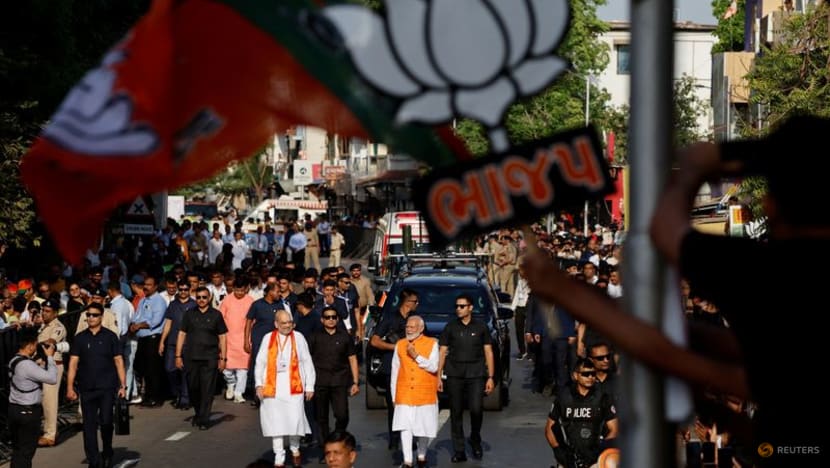Will the impact of rural-urban divide show as India enters its third phase of elections?
India's poverty level remains a projected 11 per cent, with some economists noting that the income gap has widened in recent years.

India's Prime Minister Narendra Modi shows his ink-marked finger after voting as he walks alongside Amit Shah, Indian Home Minister and leader of India's ruling Bharatiya Janata Party (BJP) during the third phase of the general election, in Ahmedabad, India, May 7, 2024. REUTERS/Adnan Abidi

This audio is generated by an AI tool.
MAHARASHTRA, India: Farmer Baliram Rane lives in a rural part of Maharashtra, about 70km from India’s financial capital Mumbai.
He has three daughters to provide for, but he says he is lucky if he manages to make US$150 a month selling his produce.
“We can only fill our stomachs with that money and nothing else. We don't have savings. We use this money for our household expenses,” he told CNA.
His life in rural India, where two-thirds of the country’s population live, is a stark contrast from those who live in the cities, where wealth is largely concentrated.
It is up to farmers like Mr Rane to help incumbent Prime Minister Narendra Modi win a historic third term in power, with the state of Maharashtra going to the polls on Tuesday (May 7) in the third phase of the Indian elections.
Rural voters helped to bring Mr Modi back to power in 2019.
This time, 543 parliamentary seats are up for grabs in the ongoing general elections. Polling for more than half of the seats will be completed on Tuesday.
DISPARITY BETWEEN URBAN AND RURAL INDIA
Over the last decade under Prime Minister Narendra Modi's government, India has achieved an average annual growth rate of 7 per cent, propelling it to become the world's fifth largest economy.
Such strong economic growth is one of the key achievements Mr Modi is highlighting as he seeks re-election in the ongoing polls.
Earlier this year, government think tank Niti Aayog published a report that said up till last year, almost 250 million people had been lifted out of poverty within the decade Mr Modi was in power.
However, India's poverty level remains a projected 11 per cent, with some economists noting that the income gap has widened in recent years.
The report also showed that the number of citizens in “multidimensional poverty” - which refers to deprivation across income, education, and basic infrastructure - between 2019 and 2021 was 19 per cent in the rural population. This was about four times more than in urban areas.
“The combined effect of demonetisation, GST (Goods and Services Tax), and subsequently the pandemic and reverse migration - these are the factors which have impacted rural income,” said Mr Sujan Hajra, chief economist at financial services provider Anand Rathi Shares and Stock Brokers.
“That is why there is an increasing feeling of disparity between rural and urban India.”
During the demonetisation exercise in 2016, India’s two highest value banknotes were banned overnight, while the GST was launched in 2017.

BETTER LIVES FOR RURAL HOUSEHOLDS
Despite the gap between those from urban and rural areas, life appears to be improving for those who are worse off in India.
Government data released earlier this year showed that household spending has more than doubled in both urban and rural India in over a decade.
Although the average monthly expenditure in urban India was higher than in rural India, the survey showed that spending by rural households grew at a similar pace.
Economists said such data does not necessarily square with the consensus view that the post-pandemic economic recovery has lagged behind in rural areas.
Niti Aayog CEO BVR Subrahmanyam said food was, for the first time, making up less than half of the total expenses for rural households.
However, he added that this was due to households buying more products such as television sets, mobile phones and cars, as opposed to consumption levels of food going down in absolute terms.
While critics have questioned the methodology used to derive such data, and if lives are indeed better for rural households, Mr Rane said the government has done a lot to help him.
“We get flour and rice from the government. We're happy to receive this. The Modi government has brought in a lot of schemes for farmers,” he said.
The Modi government has said it has taken several steps to help the rural population, including free food handouts and cash transfers to farmers.
However, Mr Hajra, who is also executive director of Anand Rathi, said the government is not only using freebies to bridge the gap.
“At least (based on) what they are saying, (what) they are trying to do is create infrastructure, create rural roads, create more education opportunities, and more healthcare,” he said.
While families living in rural areas may be getting help, observers said narrowing the divide between urban and rural India will require the successful implementation of longer term measures.















